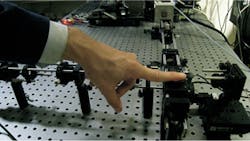Full-field OCT fingerprint scanner looks deeper for improved security
Scientists from The Langevin Institute (Paris, France) have constructed a new fingerprint imaging system that peers inside the finger to take a picture—a more reliable and secure way of identifying individuals. More important, the device is also simpler, faster, and cheaper than other technology used previously to image inside fingers. The researchers report their results in the journal Biomedical Optics Express from The Optical Society (OSA; Washington, DC).1
RELATED ARTICLE: Portable low-coherence holography creates 3D fingerprint images
In 2002, the Japanese cryptographer Tsutomu Matsumoto showed that imitation fingerprints made cheaply from gelatin, a main component of gummy sweets, could trick up to 80% of standard fingerprint scanners. The sensors also sometimes fail to recognize legitimate prints when the finger being scanned is dirty, worn, scarred, or too wet or dry.
"In the past years, the use of fingerprint sensors has expanded greatly beyond the field of forensics. Far from just being used for border security or passport registration, current uses of these sensors allows access to mobile phones, computers and even gym facilities," said Egidijus Auksorius, postdoctoral researcher, The Langevin Institute.
Despite the widespread use of commercial fingerprint sensors, problems with the devices persist, Auksorius said, including up to 5% of the population having difficulties using the sensors because their fingerprints are flattened from old age or damaged by routine manual work or sports such as rock climbing. Additionally, people attempting to escape identification might deliberately thwart the sensors by rubbing out their fingerprints, and the systems can be tricked by fake prints, as was demonstrated by Matsumoto and others.
To combat these problems, the new sensor images the "internal fingerprints," which have the same pattern as external fingerprints, but are about half a millimeter below the skin's surface. Most optical fingerprint sensors today produce images by reflecting light from areas where the skin does not come in contact with a glass plate, a technique that captures details from only the very top layer of skin. "In fact, the internal fingerprints serve as a 'master template' from which the surface regrows when it is damaged," Auksorius said.
The new sensor uses a variant of optical coherence tomography (OCT), which is already used for medical imaging and works by analyzing an interference pattern created when a beam of light that travels through a biological sample, like a finger, is recombined with a reference beam of light. Standard OCT systems gather 3D data and often require sophisticated lasers systems and light detectors, which can get expensive. Auksorius and Boccara simplified their system by using a modified version of OCT called full-field OCT, or FF-OCT, which was invented by their laboratory and developed in the early 2000s.
The main advantage of the FF-OCT system is that it can take a 2D image of the fingerprint directly, saving time and making the data processing simpler and cheaper. Because not everyone's internal fingerprints are located at the same depth, the researchers also developed a method to first take an image of the fingertip at an angle. The first image was used to determine the depth of the internal fingerprint, and then a second image of the fingerprint itself was taken.
The system can also image sweat pores, which provide an additional means of identification.
Currently the system is about shoebox size and Auksorius is working to further shrink it. The biggest and most expensive element in the system—a specialized infrared camera—costs about $40,000, but the team recently acquired comparable images using a camera less than one fifth the cost. Auksorius estimates that a complete device using the new camera could be constructed for less than $10,000. While the price is still significantly higher than standard fingerprint sensors, Auksorius predicts that the new device could find a market dedicated to imaging problematic fingerprints or in areas where security is a particular concern.
The team has plans to soon test the device in Turkey, where 100 people will have their fingerprints scanned. They are also working to further improve the imaging speed and depth capabilities of the system.
REFERENCE
1. E. Auksorius and A. Boccara, “Fingerprint imaging from the inside of a finger with full-field optical coherence tomography,” Biomedical Optics Express 6, 4465-4471 (2015).
SOURCE: OSA; http://www.osa.org/en-us/about_osa/newsroom/news_releases/2015/internal_fingerprint_sensor_peers_inside_fingertip/
About the Author

Gail Overton
Senior Editor (2004-2020)
Gail has more than 30 years of engineering, marketing, product management, and editorial experience in the photonics and optical communications industry. Before joining the staff at Laser Focus World in 2004, she held many product management and product marketing roles in the fiber-optics industry, most notably at Hughes (El Segundo, CA), GTE Labs (Waltham, MA), Corning (Corning, NY), Photon Kinetics (Beaverton, OR), and Newport Corporation (Irvine, CA). During her marketing career, Gail published articles in WDM Solutions and Sensors magazine and traveled internationally to conduct product and sales training. Gail received her BS degree in physics, with an emphasis in optics, from San Diego State University in San Diego, CA in May 1986.
